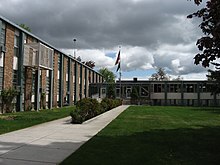Lake County, Oregon
| Lake County, Oregon | |
|---|---|

Lake County Courthouse in Lakeview
|
|
 Location in the U.S. state of Oregon |
|
 Oregon's location in the U.S. |
|
| Founded | October 24, 1874 |
| Seat | Lakeview |
| Largest city | Lakeview |
| Area | |
| • Total | 8,358 sq mi (21,647 km2) |
| • Land | 8,139 sq mi (21,080 km2) |
| • Water | 219 sq mi (567 km2), 2.6% |
| Population (est.) | |
| • (2015) | 7,829 |
| • Density | 1.0/sq mi (0/km²) |
| Congressional district | 2nd |
| Time zone | Pacific: UTC-8/-7 |
| Website | www |
Lake County is a county in the south-central region of the U.S. state of Oregon. As of the 2010 census, the population was 7,895. Its county seat is Lakeview. The county is named for the many lakes found within its boundaries, including Lake Abert, Summer Lake, Hart Lake, and Goose Lake.
Lake County is in the high desert region known as the Oregon Outback, on the northwestern edge of the Great Basin. The county is generally divided between the communities around Lakeview and Paisley to the south and the communities around Christmas Valley, Fort Rock, and Silver Lake to the north.
Its economy consists largely of agriculture and natural resource management and extraction. It is home to many large cattle ranches, hay farms, and timber holdings (both public and private), as well as several frontier towns and early 20th-century homesteads. Although lumber was once a primary economic driver in Lake County, today only one mill remains, at Lakeview.
Pre-Clovis era coprolites found in the Paisley Caves in northern Lake County in 2007 have been radiocarbon dated to 14,300 calendar years before present. DNA extracted from these human remains bears certain genetic markers found only in Native American populations.Luther Cressman found prehistoric artifacts in the Fort Rock Caves of northern Lake County in 1938, including basketry, stone tools, and a cache of woven sagebrush bark sandals which have been dated to more than 10,000 years ago.
...
Wikipedia
